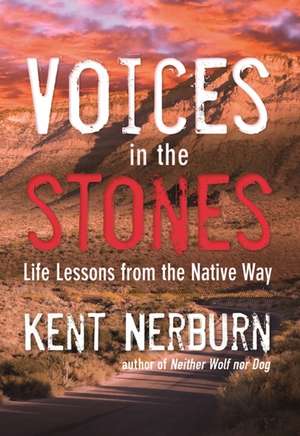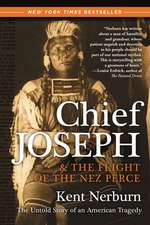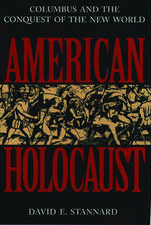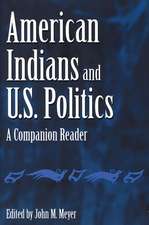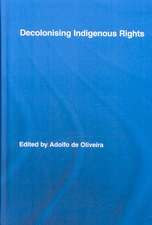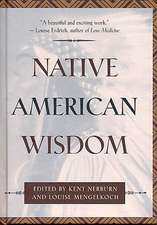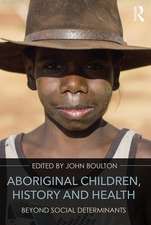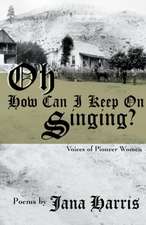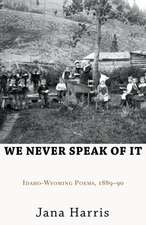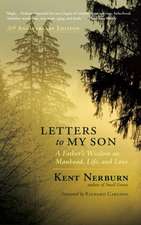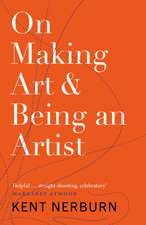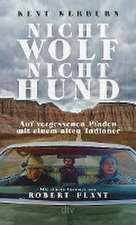Voices in the Stones: Life Lessons from the Native Way
Autor Kent Nerburnen Limba Engleză Paperback – 12 dec 2016
Native Americans are lauded for their profound spirituality and deep understanding of the land. Kent Nerburn here draws on his three decades living and working among Native peoples to offer stories and reflections that reveal what the ways of Native Americans have to teach us all — about giving, sharing, grieving, and celebrating. Nerburn takes readers inside a Native feast that highlights respect for elders, to a nearly forgotten Nez Perce battlefield, and to both the traditional burial of a young man and the reinterment of the ancient bones of two teen-aged girls. At a dusty roadside café he introduces us to an elder who remembers when his ancestors could talk to animals. Whether moving and dramatic, delightfully humorous, or all of the above, these vignettes remind us that as common children of a common land, we have much to learn from each other — if only we have the heart to listen.
Preț: 93.60 lei
Nou
Puncte Express: 140
Preț estimativ în valută:
17.91€ • 18.83$ • 14.80£
17.91€ • 18.83$ • 14.80£
Carte disponibilă
Livrare economică 27 martie-10 aprilie
Preluare comenzi: 021 569.72.76
Specificații
ISBN-13: 9781608683901
ISBN-10: 1608683907
Pagini: 192
Dimensiuni: 127 x 184 x 2 mm
Greutate: 0.18 kg
Editura: NEW WORLD LIBRARY
Colecția New World Library
ISBN-10: 1608683907
Pagini: 192
Dimensiuni: 127 x 184 x 2 mm
Greutate: 0.18 kg
Editura: NEW WORLD LIBRARY
Colecția New World Library
Notă biografică
A two-time winner of the Minnesota Book Award, Kent Nerburn is the author of thirteen books on spirituality and Native themes, including Chief Joseph and the Flight of the Nez Perce (featured on the History Channel), Neither Wolf Nor Dog, and The Wisdom of the Native Americans. He lives in Portland, OR.
Extras
NATURE IS A VOICE TO BE HEARD, NOT A FORCE TO BE CONTROLLED
The Indian and the white man sense things differently because the white man has put distance between himself and nature; and assuming a lofty place in the scheme of order of things he has lost for him both reverence and understanding — Luther Standing Bear
I am standing on a lonely, peaceful prairie in the southwestern corner of Minnesota, not far from the South Dakota border. The two men standing beside me —Martin and his father, Raymond — are Tlingit men from the small coastal village of Yakutat in Southeastern Alaska.
Raymond is a quiet man in his late 60’s, carrying the burdens of a long life spent fighting for the rights of his people against cruise lines, oil tankers, and insults against the environment. He also carries the scars of difficult times in Viet Nam and the weight of childhood experiences in the Native boarding schools. He is a survivor with a deep gentleness in his heart.
Martin, his son, is a young man just coming into his own, carrying burdens of a different sort. He is trying to live in two worlds – the traditional Native world and the world of modern American culture. It is not an easy challenge, for the two do not easily fit together. But when someone masters the challenge, it is a beauty to behold, because their life embraces the richness and promise of the American experience in a way that those of us from a single cultural experience can only dream of understanding.
It is a warm September day. The three of us are walking through the knee high grasses toward a low rock outcropping that rises like the back of a humpback whale from the center of this windswept prairie. Low buffalo grasses and prairie flowers and miles of gently undulating earth stretch in all directions to the horizon. One can easily imagine the creak of wooden wheels and billowing tops of covered wagons moving across this landscape beneath azure blue skies alive with butterflies and tumbling cottonball clouds. It is a place of profound and infinite peace.
We have come there at Raymond’s request. He and Martin are visiting me in Minnesota. I had spoken to them of the petroglyphs – small scratchings of symbols and forms that stretch for acres over these low, barely visible humps of rock that rise from this quiet prairie landscape. No one knows quite why they are here or by whom they were made. Anthropologists and historians theorize, but can do little more than guess at the meanings or the purpose of these thousands of markings. A snake form here, a stick figure there, the outline of a hand, the back of a turtle. How many generations, even aeons, did humans stop here, and for what purpose, to make these scratchings into unyielding stone? They are older than Stonehenge, older than the pyramids.
I stand transfixed, somewhere between wonder and reverie, letting my thoughts flow across the undulating prairies, while Martin and Raymond walk together – father and son -- among the glyphs and markings, lost in their own thoughts.
Soon I see Raymond get down on his knees and bend over, as if perhaps kissing the rock. Then Martin does the same. I look more closely. They are not kissing the rock, they are bringing out an abalone shell and a pouch of sage, to make their own small offering to the spirits of the people who had made these markings, and perhaps to the very stones themselves. They are not trying to understand, they are honoring the presence and the mystery.
They invite me to join them. Honored by the invitation, I kneel beside them as Martin, at his father’s instruction, lights the sage and begins an invocation to the forces that float like the butterflies across this vast and peaceful land.
I follow their lead, opening my heart in prayerful awareness to the spirits that surrounded us. It is not my world -- I am too far separated by the cultural overlays of my Euro-American upbringing and heritage. But by the gift of their invitation, I am allowed to enter into this world that stretches, in unbroken tradition, from the hands that had marked these stones to the hands that are cupping the smoke and shaping the sage on the hard rock before us.
When we are finished, we all remain silent in the echoing presence of this ancient ritual. One by one, we stand up and wander off in separate directions, across the great rock, lost in our own private thoughts. I see Martin and Raymond at a distance, silhouetted against the afternoon sky.
Below my feet I feel the presence of the great rock, now alive with a new meaning. Among the markings, barely visible, I see the outline of an ancient hand, scratched there tens of thousands of years ago by an unknown. Without thinking, I get down and place my hand against the outline. It fits perfectly.
My hand is warm. The hand in the stone is cold. But in the touch, something is passed, and I am humbled beyond understanding.
The Indian and the white man sense things differently because the white man has put distance between himself and nature; and assuming a lofty place in the scheme of order of things he has lost for him both reverence and understanding — Luther Standing Bear
I am standing on a lonely, peaceful prairie in the southwestern corner of Minnesota, not far from the South Dakota border. The two men standing beside me —Martin and his father, Raymond — are Tlingit men from the small coastal village of Yakutat in Southeastern Alaska.
Raymond is a quiet man in his late 60’s, carrying the burdens of a long life spent fighting for the rights of his people against cruise lines, oil tankers, and insults against the environment. He also carries the scars of difficult times in Viet Nam and the weight of childhood experiences in the Native boarding schools. He is a survivor with a deep gentleness in his heart.
Martin, his son, is a young man just coming into his own, carrying burdens of a different sort. He is trying to live in two worlds – the traditional Native world and the world of modern American culture. It is not an easy challenge, for the two do not easily fit together. But when someone masters the challenge, it is a beauty to behold, because their life embraces the richness and promise of the American experience in a way that those of us from a single cultural experience can only dream of understanding.
It is a warm September day. The three of us are walking through the knee high grasses toward a low rock outcropping that rises like the back of a humpback whale from the center of this windswept prairie. Low buffalo grasses and prairie flowers and miles of gently undulating earth stretch in all directions to the horizon. One can easily imagine the creak of wooden wheels and billowing tops of covered wagons moving across this landscape beneath azure blue skies alive with butterflies and tumbling cottonball clouds. It is a place of profound and infinite peace.
We have come there at Raymond’s request. He and Martin are visiting me in Minnesota. I had spoken to them of the petroglyphs – small scratchings of symbols and forms that stretch for acres over these low, barely visible humps of rock that rise from this quiet prairie landscape. No one knows quite why they are here or by whom they were made. Anthropologists and historians theorize, but can do little more than guess at the meanings or the purpose of these thousands of markings. A snake form here, a stick figure there, the outline of a hand, the back of a turtle. How many generations, even aeons, did humans stop here, and for what purpose, to make these scratchings into unyielding stone? They are older than Stonehenge, older than the pyramids.
I stand transfixed, somewhere between wonder and reverie, letting my thoughts flow across the undulating prairies, while Martin and Raymond walk together – father and son -- among the glyphs and markings, lost in their own thoughts.
Soon I see Raymond get down on his knees and bend over, as if perhaps kissing the rock. Then Martin does the same. I look more closely. They are not kissing the rock, they are bringing out an abalone shell and a pouch of sage, to make their own small offering to the spirits of the people who had made these markings, and perhaps to the very stones themselves. They are not trying to understand, they are honoring the presence and the mystery.
They invite me to join them. Honored by the invitation, I kneel beside them as Martin, at his father’s instruction, lights the sage and begins an invocation to the forces that float like the butterflies across this vast and peaceful land.
I follow their lead, opening my heart in prayerful awareness to the spirits that surrounded us. It is not my world -- I am too far separated by the cultural overlays of my Euro-American upbringing and heritage. But by the gift of their invitation, I am allowed to enter into this world that stretches, in unbroken tradition, from the hands that had marked these stones to the hands that are cupping the smoke and shaping the sage on the hard rock before us.
When we are finished, we all remain silent in the echoing presence of this ancient ritual. One by one, we stand up and wander off in separate directions, across the great rock, lost in our own private thoughts. I see Martin and Raymond at a distance, silhouetted against the afternoon sky.
Below my feet I feel the presence of the great rock, now alive with a new meaning. Among the markings, barely visible, I see the outline of an ancient hand, scratched there tens of thousands of years ago by an unknown. Without thinking, I get down and place my hand against the outline. It fits perfectly.
My hand is warm. The hand in the stone is cold. But in the touch, something is passed, and I am humbled beyond understanding.
